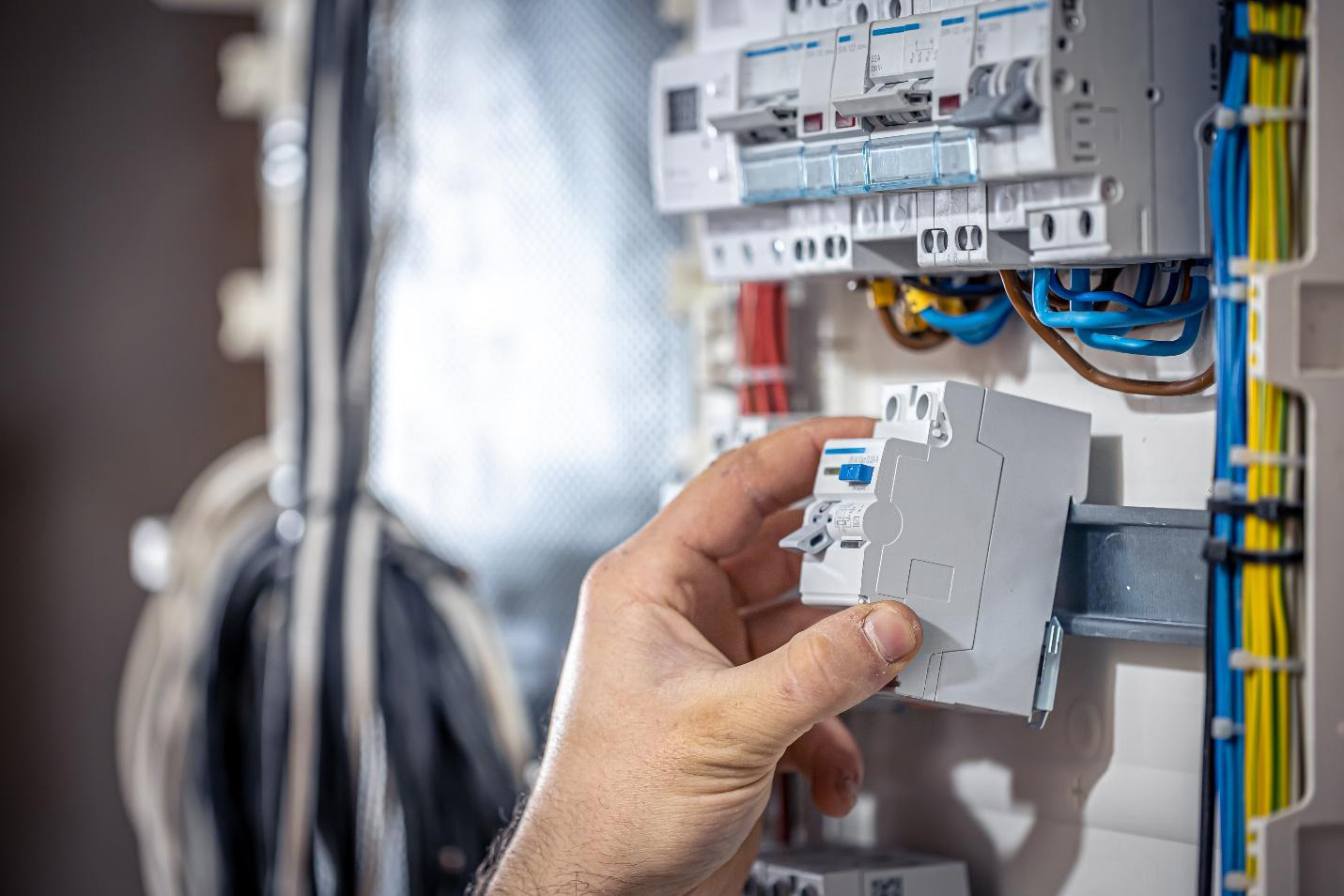Summary
Electrical panels should be replaced every 25 years. Key upgrades that every Los Angeles facility needs for enhanced safety and improved efficiency include replacing the electrical panel and breaker box, upgrading the electrical service panel, and enhancing surge protection and grounding.
Table of Contents
Introduction
Industrial facilities are powered by complex electrical systems that require ongoing maintenance and occasional upgrades to operate at peak efficiency. According to the Occupational Safety and Health Administration (OSHA), maintaining an up-to-date and properly functioning electrical system is crucial for ensuring workplace safety and preventing injuries and fatalities.
In this article, we examine the top 5 electrical panel upgrades necessary for your Los Angeles facility. Our experts will also discuss the benefits of upgrading electrical panels, including regulatory compliance, enhanced safety, reduced downtime, and protection against equipment damage.
1. Electrical Panel Replacement
Understanding the role of an electrical panel is crucial for maintaining the safety of your commercial building. An electrical panel distributes power from the main line to various circuits throughout your building. There are many benefits to upgrading electrical panels. An outdated or overloaded electrical panel can cause serious safety hazards and hinder your building’s efficiency. Replacing your panel ensures that your building can handle modern electrical demands.
Why It Matters
Your electrical panel is responsible for distributing electricity throughout your facility. Over time, these panels become outdated, overloaded, or damaged, leading to inefficient operation, electrical shocks, downtime, and even electrical fires.
According to the U.S Consumer Product Safety Commission (CPSC), many homes have outdated electrical systems that may not be able to handle modern electrical demands safely. This also applies to commercial and industrial facilities.
As most industries and work processes rely on electronics, HVAC systems, and high-power machinery, your panel must be able to meet those needs efficiently and safely.
Benefits of Upgrading Electrical Panel
The following are some reasons to upgrade your electrical panel:
- Increased Electrical Capacity: Upgrading to a modern electrical panel enables the distribution of more electrical power throughout your building. This means you can power more devices and appliances without overloading your electrical system.
- Future-Proofing: Upgrading your electrical panel ensures that your electrical system can accommodate future electrical demands, providing flexibility for future expansions, renovations, or electrification projects and saving you from costly upgrades in the future.
- Code Compliance: Commercial buildings in Los Angeles are required to meet the current National Electrical Code (NEC) standards. An upgraded panel will help you pass regulatory inspections and avoid sanctions, fines, and loss of operating license.
Electrical Panel Replacement Cost
Electrical panel replacement cost in Los Angeles ranges from $1,500 to $3,000, depending on several factors such as:
- Panel Size: 100-150 amp panels range from $1,500 to $2,000, while larger commercial and industrial panels can cost upwards of $3,000.
- Labor and Installation: Labor takes 40-60% of the total installation cost. The average rate for a licensed electrician in Los Angeles ranges from $75 to $150 per hour.
Permits and Inspections: Electrical panel replacement requires regulatory approval to ensure code compliance and safety. Permit fees in Los Angeles range between $200 and $500.
2. Breaker Box Replacement

The breaker box is a crucial part of your electrical system. The box houses your circuit breakers, which protect your electrical appliances, gadgets, and building in case of an overload. The average breaker box has a lifespan of 25 to 40 years. So, if your building is an older one, your breaker box should be inspected to ensure it can handle modern electrical demands.
Signs You Need to Replace Your Breaker Box
The following are signs that you need your breaker box replaced:
- Frequently Tripping Breakers: If your circuit breakers are tripping more regularly than usual, it’s a sign that something is wrong. Breakers are designed to cut power when circuits get overloaded to prevent electrical fires. When it trips more frequently, it means your panel can not handle your electricity demands.
- Old or Outdated Panels: If your breaker panel is nearing or has exceeded 25 years of age, it is a sign that it has likely outlived its lifespan. An older panel is more susceptible to failure and poses an increased risk of electrical hazards, including electric shocks and fires.
- Visible Rust or Corrosion: Moisture damage, such as rust or corrosion, affects the safety and function of breaker panels. Corrosion can cause your breakers to stick or fail to trip properly when needed. This creates serious electrical fire hazards due to increased electrical resistance and short circuit risks.
- Buzzing or Humming Sounds: Your breaker box should be silent. If you notice strange sounds coming from the box, it is likely due to loose wiring connections or electrical arcing occurring inside the box. Strange sounds from your breaker box indicate that your system is not operating optimally and may lead to overheating or fire hazards, unless it is replaced.
- Burning Smell: A persistent burning smell from your system is a sign of overheating or failing breaker components. When this happens, your entire system and building are at risk of overheating and electrical fires.
Breaker Box Replacement Cost Breakdown
The cost of replacing your breaker box in Los Angeles depends on factors such as panel size and amperage, building layout, permitting, and any necessary electrical upgrades.
- Panel Size and Amperage: Larger capacity panels, suitable for commercial and industrial use, cost more.
- Building Layout: Old panels in hard-to-reach areas will be more expensive to remove and replace.
- Permitting: Local regulations require inspections and permit fees to ensure code compliance.
- Additional Electrical Work: If other electrical work, such as rewiring, upgrading bonding and grounding, and GFCI/AFCI breaker upgrades, will cost more.
Why It’s a Smart Investment
Some benefits of upgrading electrical panel and breaker box include:
- Enhanced Safety: One of the primary reasons to consider replacing your breaker box is safety. Older breakers can’t reliably shut off power in the event of a short circuit or overload, increasing the risks of electrical fire or shocks. Replacing your breakers ensures that safety standards are met.
- Increased Property Value: A modern, code-compliant electrical system is considered a desirable feature by homebuyers and can increase the resale value of your property.
- Futureproofing: Replacing your breaker box ensures that you stay ahead of the curve, ensuring your electrical system is up-to-date and compliant with current regulations, while reducing future upgrade costs.
3. Electrical Service Panel Upgrade

An electrical service panel upgrade means increasing the capacity of the main panel that distributes power to your entire building. A licensed commercial electrician should perform this process to prevent cost overruns and ensure a safe, code-compliant upgrade.
Why You Might Need One
You should upgrade your electrical service panel if:
- You have more devices or equipment that require additional power, such as HVAC systems, electric vehicle (EV) chargers, office equipment, and servers.
- You have frequent breaker trips.
- Your panels are over 25 years old.
Benefits
As a commercial building in Los Angeles, the benefits of upgrading electrical panel include:
- Code compliance
- Employee safety
- Higher property value
4. Energy-Efficient Lighting Upgrades
Switching to energy-efficient lighting means your building can use the same amount of light for less cost. According to the Department of Energy (DOE), lighting accounts for about 15% of an average home’s electricity use. This applies to industrial and commercial buildings.
LED and Smart Lighting Systems
If you are using incandescent light bulbs, switching to LED lights is one of the fastest ways to reduce your energy bills. When considering LED lighting systems, prioritize bulbs with the ENERGY STAR rating.
In addition to LED lights, consider using smart controls, such as dimmers, timers, and sensors, to reduce electricity consumption further. Timers automatically turn off lights when they are not in use, and dimmers can be used to lower light levels. Sensors also control light based on occupancy or daylight, helping to save energy and reduce utility bills.
Efficiency Gains
LED and smart lighting systems help to achieve:
- Lower energy bills by up to 75% in commercial buildings.
- Reduced maintenance costs as LEDs require less frequent replacement, minimizing labor and downtime.
5. Surge Protection and Grounding Enhancements
Power surges and poor grounding can compromise your electrical systems, resulting in equipment damage and potentially leading to electrical shocks and fires. Upgrading your surge protection and grounding systems is key to a safe, efficient, and reliable electrical system.
What’s at Risk?
Poor surge protection and grounding can lead to:
- Equipment Damage: Expensive equipment and appliances, such as computers, servers, and medical devices, can be damaged or destroyed, leading to costly downtime, expensive repairs or replacement, and lost data.
- Electrical Fires: Power surges and poor grounding can cause overheating in your electrical system. Over time, this can ignite fires and cause a safety hazard to personnel.
- Insurance and Compliance: Outdated or poorly maintained systems can void your insurance coverage in the event of a surge-related loss. Regulatory bodies, such as OSHA and the National Electrical Code (NEC), require proper grounding and surge protection for employee safety.
Upgrade Options
Upgrade options for your facility include whole-building surge protection, which protects everything from your HVAC system to heavy machinery. You can also use point-of-use protection for individual equipment, complementing whole-building protection.
Conclusion
The various benefits of upgrading electrical panel include ensuring personnel safety, future-proofing your business, and ensuring code compliance. Reliable and safe electrical systems also help boost productivity and reduce costly downtime, positioning your business for long-term success. Contact a commercial electrician today to upgrade your electrical systems.
FAQs
The cost of upgrading your electrical panel is offset by enhanced safety, a reliable power supply, efficient work processes, reduced downtime, and regulatory compliance. All of which translates into long-term business success.
Upgrading your electrical panel to 200 amp provides your building with a higher capacity and prevents overloading and common electrical hazards.
If you don’t upgrade your panel, you run the risk of malfunctioning circuit breakers, overloading, overheating, and ultimately, electric shocks and fires.
Yes, upgrading to a higher capacity panel boosts the resale value of your home as potential buyers and renters will prioritize a building with safe and efficient electrical systems.
Tercero Inc. offers reliable and efficient electrical panel servicing, replacement, and upgrades. Contact us for a free quote.
Yes, you can upgrade your electrical panel without rewiring the entire building if the current wiring is up to code and showing no signs of damage.
A new electrical panel will reduce the risks of costly repairs and equipment damage, improve energy efficiency, and reduce maintenance costs.
Yes, a 50-year-old panel is too old to function effectively. It lacks modern safety features and the capacity to handle the demands of modern electricity.
You need a licensed commercial electrician for a safe, reliable, and efficient electrical panel upgrade.
Frequently tripping breakers, a burning smell, strange sounds, flickering lights, and the age of the panel are key factors that indicate your electrical panel is due for an upgrade.

